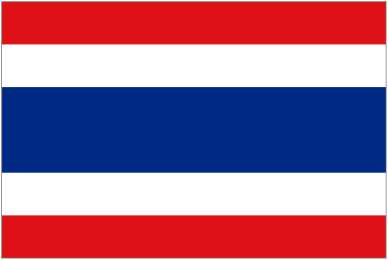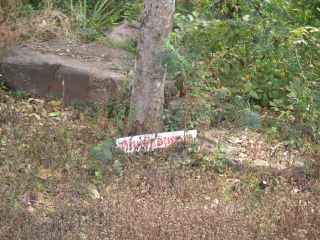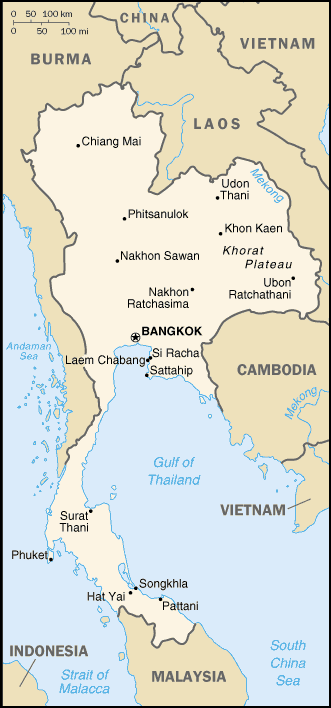|
fotopagina
What about...
...Beergirls?
The first time encountered this, I was travelling in Cambodia and I tell you it is service optima forma, So you ask, what are beergirls (biermeisjes)? Well I explain. When you go to a good bar there are normally a lot of personal working. Now that by itself is not strange when you travel in Asia. I mean most shops have for every counter a sales person, you sometimes ask yourself what they do all day, especially when there are not many customers, but, they work and make at least some money. Now when you normally go to a bar a waitress will sell you a drink bring it to you and that's it. But not with the beergirls here. They not only bring you your drink, they fill the glass for you aswell and being in Asia, also filling the glass with ice. Yes, you drink all your drinks with ice, including beer. I know, it is some getting used to, but at least the beer stays cool and you get less drunk. Now the beergirls serve one or two tables, maybe more and they keep an eye on your glass, as soon as it half full or empty for that matter, they take it and fill it up again, Besides that, they might try to have a conversation with you (if they speak any English that is). Now when I saw this the first time in Phnom Penh in Cambodia, it went a bit further. At this roadside bar/restaurant they sold different kind of beers and the waitresses wore a T-shirt with a brandname on it. So if you ordered a Heineken, the girl with the Heineken shirt would serve you and fill up your glass. The girl with the Tiger shirt did the same for the Tiger clients, as did the Budweiser, the Singha and Chiang girl. Strange? Well a little bit, but a better service you can not get. Oh and another strange thing about bars in Thailand...you take your own whisky or rum to the bar, so you only have to order water and the beergirls will serve it without asking.
...Elephants?
When I was writing the above story, people came by to sell me bananas to give to an elephant. Not strange but being it dark, the elephant had a red taillight...on his tail. Strange?? Yes I think so.
...Motortaxis?
And again I stumbled upon the next form of transportation, the motortaxi. You see them in Thailand in the bigcities, but also at busstops in the country side. It is nothing more then a Honda 110 cc automatic motor, coming with a driver wearing a safety vest, in the cities with a number on the back. In the cities they will wait at busstations or busstops on the through roads. They are cheaper than a Tuktuk, but only takes one. In the small cities there are no Tuktuks, so your only option. Sometimes busses will drop you of at a crossings to a city or site, normally there will be one waiting for you. Backpack is no problem. You can also use them to visit sites, as I did in Ban Prasat and to What Wihan. So we can add this on the list of different kind of transport.
|

Thailand
08-02-2008 t/m 19-02-2008
Ja, en toen was ik weer terug in het land van de glimlach. De grens tussen Laos en Thailand is super modern, alhoewel de douane nu nog in een oud gebouwtje zit, is men een complete terminal aan het bouwen. Je moet hier al een stukje doorheen en ik waan me op een hypermodern vliegveld. Na alle formaliteiten, loop ik met een stel duitsers langs alle shopjes naar het busstation. We kunnen gelijk instappen in een grote sãwngthãew naar Phibun. Hier gelijk verder in een 'normale' bus naar Ubon Ratchathani, bus dropt ons netjes midden in de stad. Ik neem een kamer in hotel Tokyo en ga de stad in, het is intussen al bijna 15.00 uur. Ubon Ratchathani is een grote stad en na een maand Laos is het weer wennen aan de luxe. 7 Eleven, McDonalds, Tesco en alle westerse dingen kun je weer krijgen. De rest van de dag besteed ik aan het inwinnen van info bij TAT office (touristenbureau), internet, eten ed. De dag erna wil ik een brommer huren, maar helaas, geen beschikbaar. Dus met de sãwngthãew naar het busstation om naar Prasat Khao Wihan National Parc te gaan om een tempel te bezoeken, zie '...seeing a temple'. Kost dus nogal wat tijd, maar het is de moeite waard. De zondag gebruik ik om de sites in de stad te bezoeken, diverse What's, national museum, Tesco (even afkoelen) en neem een goede massage. De 11de neem ik eerst de bus naar Surin, maar besluit daar vandaan gelijk door te gaan naar Nang Rong. Een klein plaatsje op de route naar de diverse tempels. Hier huur ik de volgende dag een brommer en bezoek Phanom Rung, een mooi gerestaureerde Khmer tempel met een goed museum. Dan tuf ik een flink eind door om de drie sites Prasat Ta Meuan te zien. Deze drie weinig bezochte tempels liggen twee uur van Nang Rong op de grens met Cambodja. De eerste is klein, is een gebouw wat meer lijkt op een kerk. Tweede wat groter, is ommuurd en heeft een vijver. De derde ligt strak op de grens, wederom aan het einde van de weg (is een goede tweebaansweg zonder verkeer), achter de tempel loopt alleen een smal pad de jungle in. Veiligheidshalve wordt geadviseerd niet hier heen te gaan, schijnbaar liggen er nog veel landmijnen uit de Pol Pot era.

Waarschuwing voor landmijnen
Deze tempel alleen is de moeite van de rit waard, schitterend. En geen toerist te zien, alleen een enkele soldaat. De dag erna neem ik de bus naar Nakhon Ratchasima ofwel Khorat. Dit is een grote plaats met maar een paar interessante plekken. De 14de neem ik een sãwngthãew naar het busstation en vandaar de bus naar Phimai. Hier zie ik eerst een paar honderd jaar oude Ficus benjamina. Bijzonder omdat hij niet hoog is, maar met al zijn lianen zo'n beetje een voetbalveld bestrijkt, je loopt letterlijk door een bos van lianen. In Phimai is ook de best gerstaureerde Khmer tempel in Thailand, geeft een goed beeld van de macht van de Khmer in die tijd. Op de terugweg naar Khorat stop ik nog bij Ban Prasat. Hier zijn een aantal grafplaatsen te zien uit het begin van de jaartelling. Te zien zijn de skeletten en potten en armbanden. Heel apart. Achterop een brommer zie ik de drie opgravingen. De 15de neem ik de trein naar Bangkok, neem een ander hotel in mijn intussen bekende straat en ga de malls in. Ben op zoek naar Lariam, maar dit is niet gewoon te krijgen. Ga hiervoor zaterdag naar een tropisch ziekenhuis en krijg uiteindelijk een recept. Blijkbaar adviseerd men hier niet om preventief medicijnen tegen malaria te gebruiken. Na het ziekenhuis naar het station voor de trein naar Hat Yai, helaas kan ik pas maandag een plaats krijgen. 's Middags doe ik cultureel en wandel via China town naar de royal area waar ik What Pho, bezoek. Dan terug lopen naar Siam square. De zondag heb ik last van m'n darmen en doe ik rustig aan, update mijn website. Maandag de 18de stuur ik een flink pakket naar huis en heb ik de trein van 15.35 pm naar Hat Yai. Hier arriveer ik dinsdag om 9.50 am en neem gelijk een lokale trein naar Sungai Kolok. Is eveneen andere situatie hier in het zuiden. In de trein en vooral op de stations veel politie en militairen met kogelvrijevesten en geweren. Het is hier duidelijk nog steeds onrutig. In Sungai Kolok wandel ik naar de grens, ja ik verlaat Thailand vandaag. Douane is bijna nog trager dan op het vliegveld in Bangkok, maar ik krijg mijn departure stempel en loop de grens over naar Maleisië.

|
What about...
...Seeing a temple?
One of the highlights of northeast Thailand is What Khao Wihan, a temple in the Angkor style, just across the border in Cambodia. The temple used to be on the Thai side, but an international ruling put it in Cambodia. Problem is that you can only visit it through Thailand. So when I was staying in Ubon Ratchathani I decided to go there. Now that sounds easier than it was. First I wanted to rent a motorcycle, but the only place renting them had none left. So at 8.30 am I took a sãwngthãew to the busstation and took a bus at 9.15 am to Kanthararak. Now is this only about 50 kilometer, but the average speed of this bus was, when it was going that is, 30 km/hr. I arrived in Kanthararak at 11 am. At 11.25 am I got a sãwngthãew to Phum Saron, here I got dropped off at 12.30 to change transport. Meaning I had to hire a motortaxi from there for the last leg of 10 kilometer. This guy was in a hurry and drove with an average speed of 70 km/hr. When entering the Prasat Khao Wihan National Parc I had to pay a park fee of 200 Baht ( about € 4,25). When we finally arrived at the border it was almost one o'clock. I first watched and enjoyed the views of the park, as the parking was on top of a hill. Then I walked to the border (now this is a dead end road so everyone going to the temple has to come back), this is no more then a shed. The officer takes a copy of your passport and you pay 5 Baht for a borderpas. Then you walk on, in the hot sun to the end of the road and then over rocks till you hit a sort of gate in a bit of fence. Here are sitting some Cambodian soldiers doing nothing, not even wanting to see your passport, a bit further is a tickets booth where you pay another 200 Baht entreefee for the temple. Then you walk passed duty-free stalls selling booze and cigarettes before you finally arrive at the temple. And it is worth the trip, the temple is big and everytime you think this is it you can climb higher to the next complex. Now at 15 am I decided to go back, first bit again on the back of Andretti (he with helm, passengers don't have to), back to Phum Saron. Here I buy some cookies for lunch and start waiting for the sãwngthãew. After half an hour my driver comes back and tells me there are no sãwngthãew going anymore, but he is willing to take me for an 'cheap' 160 Baht. So I started hitchhiking and within five minutes I sat in the back of a pickup to Kanthararak. This goes fast and at 16.10 p.m. I am at the busstation, in time for the bus of 16.30 p.m. (next 18 p.m.) back to Ubon Ratchathani where I rived at 19.30 p.m.. So to see this temple for two hours, I traveled for 8,5 hours spending 850 Baht and really enjoyed it. |